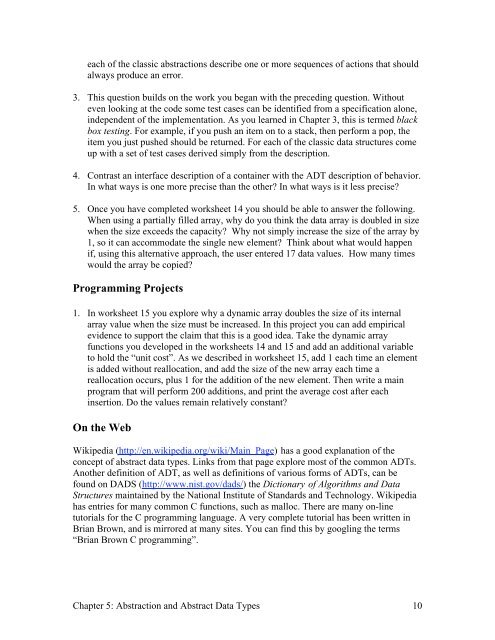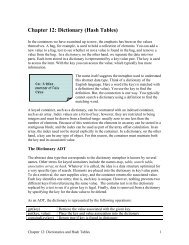Chapter 5: Abstraction and Abstract Data Types - Classes
Chapter 5: Abstraction and Abstract Data Types - Classes
Chapter 5: Abstraction and Abstract Data Types - Classes
Create successful ePaper yourself
Turn your PDF publications into a flip-book with our unique Google optimized e-Paper software.
each of the classic abstractions describe one or more sequences of actions that should<br />
always produce an error.<br />
3. This question builds on the work you began with the preceding question. Without<br />
even looking at the code some test cases can be identified from a specification alone,<br />
independent of the implementation. As you learned in <strong>Chapter</strong> 3, this is termed black<br />
box testing. For example, if you push an item on to a stack, then perform a pop, the<br />
item you just pushed should be returned. For each of the classic data structures come<br />
up with a set of test cases derived simply from the description.<br />
4. Contrast an interface description of a container with the ADT description of behavior.<br />
In what ways is one more precise than the other? In what ways is it less precise?<br />
5. Once you have completed worksheet 14 you should be able to answer the following.<br />
When using a partially filled array, why do you think the data array is doubled in size<br />
when the size exceeds the capacity? Why not simply increase the size of the array by<br />
1, so it can accommodate the single new element? Think about what would happen<br />
if, using this alternative approach, the user entered 17 data values. How many times<br />
would the array be copied?<br />
Programming Projects<br />
1. In worksheet 15 you explore why a dynamic array doubles the size of its internal<br />
array value when the size must be increased. In this project you can add empirical<br />
evidence to support the claim that this is a good idea. Take the dynamic array<br />
functions you developed in the worksheets 14 <strong>and</strong> 15 <strong>and</strong> add an additional variable<br />
to hold the “unit cost”. As we described in worksheet 15, add 1 each time an element<br />
is added without reallocation, <strong>and</strong> add the size of the new array each time a<br />
reallocation occurs, plus 1 for the addition of the new element. Then write a main<br />
program that will perform 200 additions, <strong>and</strong> print the average cost after each<br />
insertion. Do the values remain relatively constant?<br />
On the Web<br />
Wikipedia (http://en.wikipedia.org/wiki/Main_Page) has a good explanation of the<br />
concept of abstract data types. Links from that page explore most of the common ADTs.<br />
Another definition of ADT, as well as definitions of various forms of ADTs, can be<br />
found on DADS (http://www.nist.gov/dads/) the Dictionary of Algorithms <strong>and</strong> <strong>Data</strong><br />
Structures maintained by the National Institute of St<strong>and</strong>ards <strong>and</strong> Technology. Wikipedia<br />
has entries for many common C functions, such as malloc. There are many on-line<br />
tutorials for the C programming language. A very complete tutorial has been written in<br />
Brian Brown, <strong>and</strong> is mirrored at many sites. You can find this by googling the terms<br />
“Brian Brown C programming”.<br />
<strong>Chapter</strong> 5: <strong><strong>Abstract</strong>ion</strong> <strong>and</strong> <strong>Abstract</strong> <strong>Data</strong> <strong>Types</strong> 10

















